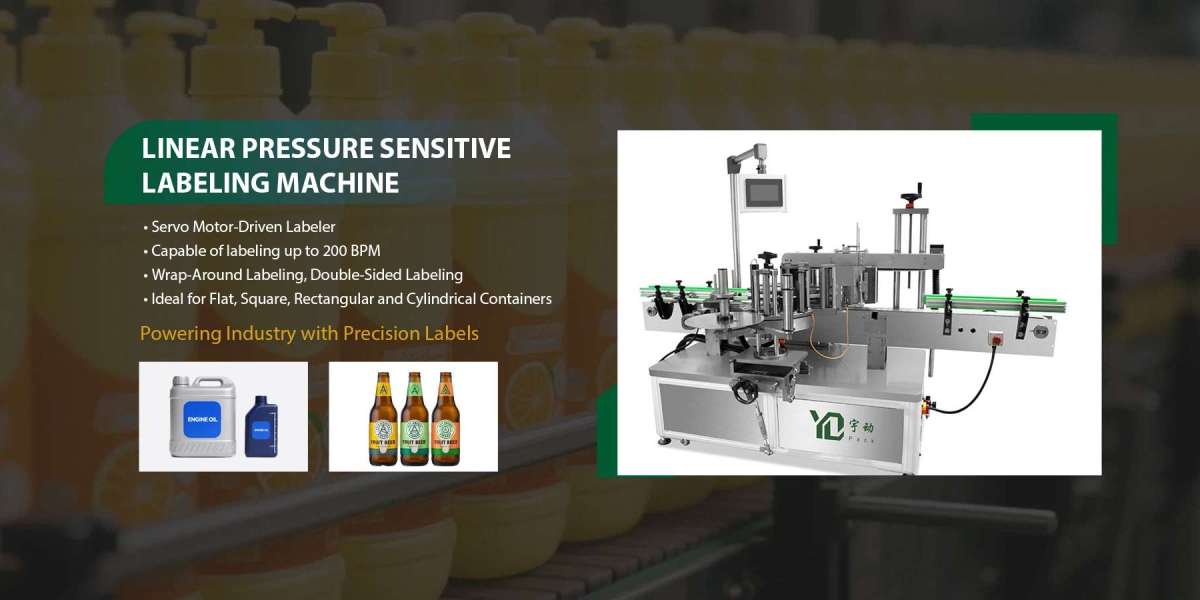In the modern packaging industry, labeling is more than just attaching a sticker—it’s about precision, efficiency, and brand presentation. With the growing demand for faster production lines and durable, high-quality labels, manufacturers are increasingly turning to advanced labeling technologies. Among these, pressure-sensitive and hot melt glue labeling machines have emerged as the backbone of efficient packaging, available in both rotary and linear configurations.

Understanding Rotary and Linear Labeling Machines
Rotary labeling machines are designed for high-speed production. Containers rotate on a drum while labels are applied continuously, ensuring consistent placement. Rotary Pressure Sensitive Labeling Machines offer the advantage of quick, clean labeling, ideal for products requiring high-speed operations such as beverages, cosmetics, and pharmaceuticals. Meanwhile, Rotary Hot Melt Glue Labeling Machines combine speed with durability, providing strong adhesion even on curved or irregular surfaces, making them perfect for heavy-duty labeling tasks.
Linear labeling machines, on the other hand, apply labels in a straight-line motion as containers move along a conveyor. These machines are highly flexible and can handle various container shapes and sizes. A Linear Pressure Sensitive Labeling Machine is perfect for medium-speed production lines where label changeovers must be quick and clean. Similarly, a Linear Hot Melt Glue Labeling Machine allows precise application of durable labels on challenging container surfaces, ensuring long-lasting adhesion.
Pressure Sensitive vs. Hot Melt Glue Systems
Choosing between pressure-sensitive and hot melt glue systems depends on product requirements and production conditions.
Pressure-sensitive labeling machines utilize pre-coated adhesive labels that stick instantly when pressure is applied. They are easy to operate, require minimal maintenance, and provide a clean application process. This system is ideal for products where rapid labeling and minimal downtime are priorities.
Hot melt glue labeling machines, in contrast, use molten adhesive to attach labels securely. They are designed for products that require strong, durable adhesion under varying environmental conditions. Hot melt glue systems are particularly suitable for irregular surfaces, containers exposed to moisture, or packaging that must endure long-term handling.
Innovations Driving Efficiency
Modern labeling machines integrate automation, smart sensors, and digital control systems to optimize performance. High-speed Rotary Pressure Sensitive Labeling Machines now feature automatic tension control and advanced alignment systems, ensuring each label is placed with precision. Similarly, Rotary Hot Melt Glue Labeling Machines include automated glue application and temperature control, reducing waste and enhancing productivity.
For linear systems, Linear Pressure Sensitive Labeling Machines now offer adjustable conveyors and container guides, allowing manufacturers to switch product types quickly. Linear Hot Melt Glue Labeling Machines incorporate programmable glue application patterns, ensuring secure adhesion even on complex container shapes. These innovations reduce human error, minimize downtime, and improve overall labeling consistency.
Choosing the Right Labeling Solution
Selecting the ideal labeling machine depends on several factors:
Production Speed: Rotary systems are suited for high-volume operations, while linear systems handle medium-speed or variable production lines effectively.
Container Type: Irregular shapes often require linear machines, while standard bottles or jars work well with rotary systems.
Adhesion Needs: Pressure-sensitive systems are quick and clean, while hot melt glue ensures durability on challenging surfaces.
Maintenance and Flexibility: Pressure-sensitive machines require minimal maintenance, whereas hot melt glue systems may need regular cleaning and temperature management.
Conclusion
The evolution of labeling technology has enabled manufacturers to meet the dual demands of speed and quality in modern packaging. Rotary Pressure Sensitive Labeling Machines and Rotary Hot Melt Glue Labeling Machines provide high-speed solutions for large-scale operations, while Linear Pressure Sensitive Labeling Machines and Linear Hot Melt Glue Labeling Machine deliver flexibility and precision for diverse container types.
By carefully considering production requirements, container shapes, and adhesion needs, manufacturers can select the optimal labeling system. Leveraging these innovations not only boosts efficiency and reduces waste but also enhances brand presentation and ensures long-term product integrity. Investing in the right labeling technology is a key step toward maintaining competitiveness in today’s dynamic packaging landscape.



